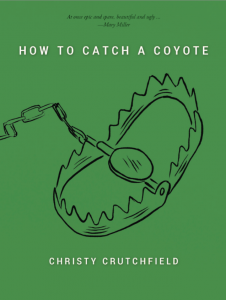208 pages, $14.95
Review by Michelle Dove
The multi-perspective novel isn’t new. Think Middlemarch and To the Lighthouse, for starters. But multi-perspective novels have populated the literary mainstream in recent years, some with shifts as complimentary to the text as Juno Díaz’s The Brief Wondrous Life of Oscar Wao or as gimmicky as Colum McCann’s Let the Great World Spin. For better or worse, multiple perspectives are marketable in today’s attention-waning culture, where the worse often sacrifices an engaging form for mediocre content. In truth, authentic narrative switches within a novel aren’t so easily pulled off. Perspectives must be similar enough in intent and content for cohesion, but also distinct enough to warrant their inclusion. And while I don’t know if Christy Crutchfield initially set out to write How to Catch a Coyote from multiple perspectives, I know that the narrative shifts in her debut novel feel as natural and necessary as the setting in Lafayette, North Carolina. And place in Crutchfield’s novel is crucial.
As the novel unfolds, I find myself in an increasingly recognizable world of my youth: a small American town where waitresses “rolled silver and complained about customers asking for their numbers,” where “two-thirds of these girls dye, highlight, Sun-In their hair,” where teenagers “pass around a water bottle filled with Aristocrat and orange juice” in the town square. Crutchfield brings this contemporary south to life in succinct, potent details, and the tone here is anything but judgmental. There’s a tenderness given to the scenery and townspeople, one so delicately rendered it’s evident Crutchfield knows both the trappings and blessings of rural life. The result is an authentic account of an American family whose trials of divorce, parenting, and sibling rivalry/affection surfaces through each family member’s narrative. The imagination of How to Catch a Coyote thus resides less in the characters or story, both of which ebb alongside a sadness that’s neither melodramatic nor escapable, and more in the story’s telling. Beyond the measured reveal of each character, it’s Crutchfield’s precision in language that enlivens this world and challenges us to look carefully, interrogate farther.
What mostly lends Crutchfield control over the narrative is repetition. Sometimes the repetition forms the novel’s scaffolding, seen most clearly in three chapters titled “A List of Fears.” Other times repetition is at the sentence level and largely lyrical:
“They are starting to learn it’s better to walk away, even when the formerly shy girl who started this problem follows you home. They don’t believe Daniel will get into his dorm tonight, but they do believe he’ll get into Carly. They are starting to learn that even if sex ends in climax, it isn’t always satisfying. They are starting to learn that a bar isn’t always satisfying.”
The sentence structures, subject-verb pairings, and repeated negations lend this passage a melody all its own, one that tunnels into the characters’ rationale. Other times repetition takes more intricate turns to complicate the unfolding action:
“He knows what she’s like. Dirty blonde. That she’ll want him to push her against walls, shove her onto the bed. The kind he’ll have to tell, I’ve done it before. The kind he won’t tell, Three times. The kind he’ll want to tell, With a girl much sweeter than you. But with the way this girl will be used to having it, maybe it’s like he’s never done it. She’d be another one of those girls who has no business liking him, but takes to him in a strange way that never feels earned. Earned is all he wants.”
Here, repetition undercuts itself to complicate both characters’ intentions. The result is palpable—Crutchfield’s lyrical rhythms bind the novel in a manner that neither feels literary for literature’s sake nor overtly flattening to the many narrative switches. Similarly weighty are Crutchfield’s terse statements that illuminate characters while projecting the narrative outward. Lines such as “Daniel already has a girlfriend, and a nice girl knows when she’s not wanted in a room anymore” exhibit the relentlessness of Crutchfield’s prose—prose that’s packed with small truths that resonate beyond the characters. And in a novel that clocks in around 200 pages, there’s no room for anything less.
Saving any spoilers, the ending of How to Catch a Coyote is just slight enough to wonder if it’s “right.” Yet leaving us off this way is wiser than fabricating a spectacular ending. In the character-driven reveal of this family’s dark humanity, Crutchfield continually trusts her reader—and really, the ending is no different.
As for the coyotes (who weave throughout the narrative to bind the novel in another eloquent fashion), there’s much to take note of and take down. Just as the protagonist son must stare down his family’s vices to gradually realize his own depth, eliciting fear of the looming coyotes is his first step in transcending their threat.
***
Michelle Dove is the author of Radio Cacophony, forthcoming from Big Lucks Books. Recent writing appears or will appear in Chicago Review, Pear Noir!, Alice Blue Review and Sixth Finch. She lives in Washington, DC.
![[PANK]](http://pankmagazine.com/wp-content/themes/pank/assets/images/pank-logo-large.png)

